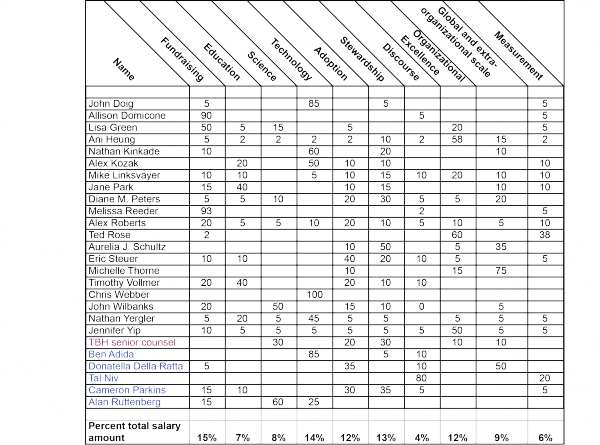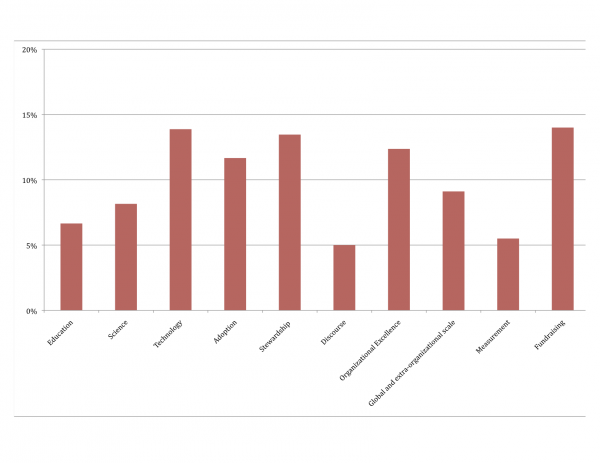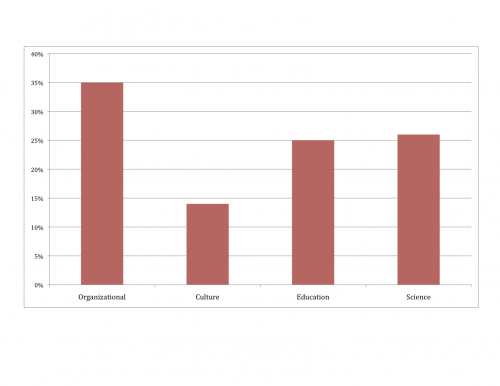Strategy
Creative Commons 2011 Strategic Plan
Note: This page may only be edited by administrators. Feedback and corrections are strongly encouraged on Talk:Strategy or via public or private email.
Introduction
Founded in 2001, Creative Commons will enter its 2nd decade in 2011.
Organizationally, it has grown from a small group of founding board members, a tiny staff, and highly concentrated funding, to a larger and increasingly diverse board, a staff of 25, affiliate institutions in 70 jurisdictions, and funding from a mix of foundations, corporations, and thousands of individuals worldwide.
In the nearly eight years since the December 2002 initial launch, CC’s licenses and public domain tools have seen tremendous adoption by individuals, institutions, businesses, communities, and governments, setting a worldwide standard for interoperable sharing.
However, the potential increase in global welfare from the use of CC’s tools has barely been tapped, and the commons are not yet central to the discourse of culture and innovation policy. CC the organization has not reached the maturity necessary at every level to support and scale these massive impacts, nor to be certain of maintaining the confidence of stakeholders, from individuals to governments, that CC ought to be entrusted as the central steward of tools for interoperable sharing.
These are precarious times for the commons, and for CC. This plan assumes that the challenges are tractable and that the entire organization must focus completely on achieving the maturity, support, and scale of adoption necessary to make the world of 2021 far more creative, equal, innovative, and participatory – as enabled by a vibrant commons.
External Trends (threats) and Theory of Change
Sharing is growing rapidly, yet so is control. Proprietary entrepreneurs and corporations, and control-oriented policymakers in institutions and government, all have vastly greater resources at their disposal, and have decades to centuries of experience to draw on. Being out-competed by proprietary innovation, or merely crushed by control, is the primary threat to the commons, and to CC (though admittedly increased restriction could make some instances of voluntary sharing more valuable, at least temporarily).
If the value of participating in sharing increases proportionately to the extent of others’ sharing, and if the commons has the ability to scale through extremely low transaction costs and free collaboration across legal entities – then society has a hope of realizing a substantial portion of the potential benefits of the commons. So we have a clear path forward – scaling adoption of commons infrastructure, i.e., CC tools.
Another threat to a scalable commons (for which interoperability is an obvious requirement), is the failure of sharing institutions to maintain interoperability. This threat may be realized through poor CC decisions or through other sharing institutions that, through some combination of ignorance, frustration with CC, hubris, or bad intent, promote tools that do not interoperate with CC tools. These range from other small organizations to governments – an entire constellation of parties interested in making or breaking the commons – each a potential threat that must be converted to an adopter and advocate or neutralized.
This threat also implies a strategy of a focus on scaling adoption, so as to become more firmly ensconced as the standard for sharing – but also of stewardship and earning the trust of all, that CC is the organization with the best interest of creating a scalable commons at its core.
Vision
Bold description of the world in which we have achieved success. Answers the question “What is the massive and beneficent impact we aspire to?”
- Our vision is nothing less than realizing the full potential of the internet – universal access to research, education, full participation in culture, driving a new era of development, growth, productivity.
Mission
Describes at a fairly high level what we actually do and stand for, in order to effect realization of our vision.
- Creative Commons develops, supports, and stewards legal and technical infrastructure that maximizes digital creativity, sharing, and innovation.
Guiding principles
See “Assumptions” and “Practices” in the appendix: these inform and constrain our activities, and are roughly an encapsulation of what this plan implies.
High-level Plan
"Scale adoption of our tools, serve as trusted steward of interoperable commons infrastructure, and build and support the organization optimal for executing our Mission and accomplishing our Vision.
Strategies
The following strategies support the high-level plan. A different high-level plan (see “Alternative Scenarios” in Appendix) would require a different set of strategies. Note that per “Monitoring plan execution” below measurement of achievement for each of these strategies will be developed and regularly reported.
Education. Education remains an adoption/impact field with more potential than realization thus far. We will continue to focus on policy/platform adoption and interoperability, explaining our tools, and technical standards needed to unlock value of open education.
Science. Research is an area of fundamental need and explosive potential for our existing legal and technical tools. We will continue to drive policy/platform adoption and to promote our tools and technical standards within the scientific community. There is great potential for new tools enabling commons around related problem areas such as patents and technology transfer licensing. These tools and the organization’s degree of engagement with them, will be evaluated in terms of scalability, commons impact, and resource requirements and fundability, as with all of our tools.
Technology. Technology continues to be an underpinning of all of our tools and our scalability in all of the above strategies. We will continue to invest in technical leadership, with an emphasis on robust core services (websites and licenses) and innovations that can be deployed as policy or on platforms for massive adoption (i.e., prototyping and standards development, not running new production services).
Adoption. This is an over-arching strategy that runs throughout the core of every action in the organization. “How does this scale adoption?” is a question to be asked of every potential strategy and activity. The answers explain in part the inclusion of subsequent strategies. We focus our adoption efforts where a “conversion” has great downstream effects – e.g., foundation and government funder policy and technology platforms such as Google.
Stewardship and support of existing tools. In addition to pushing for massive adoption, we must continue to maintain, explain, and defend our existing copyright licenses and public domain tools – indeed, this is a prerequisite for long-term massive adoption.
Discourse. We will more aggressively take advantage of more opportunities to provide CC perspective on stories directly concerning CC (e.g., ASCAP and CBC recently) as well as to insert CC perspective in larger stories of the day (e.g., Google Books, Alzheimer’s data).
Organizational excellence. Implement and adhere to non-profit best practices in every part of organization.
Global and extra-organizational scale. We will continue to enhance our affiliate network, look for other means of scaling without growing resource requirements, and make global accessibility and functionality (e.g., linguistic, legal, cultural) a priority requirement for all products and activities.
Measurement. We continue to (and in some cases, begin to) regularly measure and report at least quarterly on all of the above.
Fundraising. Build reliable revenue through multi-year foundation grants, major donor program, and growth of corporate and individual giving.
Conclusion
This proposed strategic plan for the organization for 2011 work in support the Vision and Mission, and is congruent with the Assumptions and Practices outlined in the appendix. Like all good plans, it should not be considered static or unchangeable. However, it provides crucial structure needed to guide us in executing our Mission and making progress toward achievement of our Vision. It is absolutely essential that we communicate this plan to all stakeholders and gather feedback so as to iterate and maintain effectiveness in 2012 and beyond.
Appendix
Assumptions
The following assumptions inform our mission as well as the practices we undertake to carry out our mission:
- Voluntary methods of adding to and increasing the effective value (eg more certainty and discoverablity) of the commons have great utility.
- Welfare increase from development and adoption of these methods has barely been tapped.
- Welfare increase from mere availability of voluntary methods is vastly smaller than potential with organization developing, explaining, stewarding tools.
- There is a great danger of reduced welfare from proliferation of tools that do not interoperate or attain mindshare.
- There is a limited window of opportunity for commons infrastructure to get on a path of maximum impact, avoiding local maxima of non-interoperable commons and closed silos.
- Infrastructure for voluntary commons expansion and effectiveness is global in nature.
- Commons infrastructure (therefore providing organization) must be deeply trusted and robust to achieve potential.
- While the above effects are so big and directional we can state them as common-sense, we know very little about the economic/“environmental” impact of the details of commons infrastructure implementation.
Practices
Given our mission and the above assumptions about the world, we undertake these practices in order to effectively carry out our mission:
- Scale. All of our program activities should be directed at massively scaling our adoption and impact to meet potential. For example, except for good customer service practices of answering info emails, 1:1 and other small-time outreach should be avoided unless it is with responsible individual at institution able to implement massively; We should not develop niche tools; we must prioritize process for those not on payroll (e.g., affiliates) to scale our efforts.
- Interoperability. Any tools we develop must have interoperability as design requirement and we should prioritize explaining need for interoperability and suppressing interoperability fails where necessary.
- Stewardship. We must be maximally adopter and mission-driven and transparent. We have a near sacred responsibility as developers and stewards of the infrastructure for the commons not to mess it up.
- Leadership. We must anticipate opportunities and pitfalls and lead the way to adoption of commons infrastructure that reaches its maximum potential for increasing welfare.
- Metrics, research. We must be metrics-driven in our internal operations and development and stewardship of the infrastructure. We should prioritize helping academic study of our tools – we don't have objectivity and don’t remotely have sum of expertise needed. If we matter, we must be measured and criticized.
- Focus. Mission creep and lack of focus are the top failure risks for any organization. With a mission as audacious as ours that crosses so many domains, we must remain focused on providing and scaling the infrastructure.
- Funding. Running out of money, not having resources to reach potential, or making stupid decisions in scurry for resources are also top failure risks. Everything we do must be cognizant of appeal to our actual and potential investors – the people and organizations that already understand and agree with our mission or are aligned but not yet enlightened.
Alternative scenarios
This plan has CC focused on scaling adoption and stewardship, and the organizational maturity and support required to achieve those ends (see “High-level plan and supporting strategies” below). However, in evaluating this plan, one must consider alternatives. A few are sketched below. Of course variations and combinations are easy to imagine.
Each of these alternatives requires major resources and a differently configured organization to successfully execute against. They should not be considered as occasional not thoroughly considered proposals – if one is desired, it has to be taken as a highly strategic decision and the whole organization has to change and reorient as a result.
Build the ecosystem. CC tools are made much more valuable with services built around them – search engines, registries, remix platforms, crowdfunding, collecting societies, collaborative filtering, awards, games – the list could go on. We’ve relied on others to build the supporting ecosystem, and this has been inadequate. We have to build it ourselves, for real. Negatives: increased resource requirements, increased risk, crowding out of non-CC initiative mindshare.
Business. The organization cannot be supported through individual, corporate, and foundation donations over the long term and at the level required to accomplish its mission. We need to discover and build a much bigger business (assuming non-extraordinary profitability) to support our non-profit mission. Negatives: increased resource requirements, increased risk.
Innovate till we find the next (even bigger) thing. CC’s existing tools are great, but have limited potential. Need to try exciting ideas that support the commons, possibly even breaking interoperability (not a net negative if we’re finding something even bigger). Negatives: increased resource requirements, increased risk, threat to current tools.
Open movements. Instrumental uses of CC tools aren’t very important – what they signal is. Widespread adoption of our tools merely gives us the standing and platform to be the leading advocate for openness – and we should focus on cheering “open movements” in whatever form they take, using our tools or not. Negatives: Probably incorrect re value of instrumental use of our tools and puts at risk our capacity to promote these tools from an otherwise neutral standpoint.
Stewardship only. CC tools sell themselves – or at least the organization has no leverage to make a difference in adoption. A smaller (and easier to support and govern) organization can steward the tools such that they can still be relied upon, and the world will use them, or not. Negatives: external trends increase probability of irrelevance and of a broken commons, since no other organization is in a position to step in and provide the obvious standard tools for interoperable sharing.
Mapping Strategies to Salaries
Important note: The lists and calculations below are an illustrative exercise. The staff list has and will change in terms of composition and allocation of duties -- see http://creativecommons.org/people for current staff and organization chart. However, this section does usefully illustrate how we have broadly allocated resources.
In order to demonstrate how the organization allocates our human resources, we have mapped salary to Strategies. The CC managers reported what percentage of their time and effort is spent on Strategy and did the same for their reportees. These percentages were then multiplied by each employee’s salary in order to represent the amount of effort as a dollar value. The sum dollar value for each Strategy was then divided by the total salary expense, yielding a percentage of salary budget spent on each Strategy. A detailed breakdown of the values used in the calculation is shown in the table below. The outcome of the calculation is shown in the graph below and serves as a map of salary to Strategies.
The four categories of Organizational, Culture, Education, and Science are often used as a frame for examining the organization. The categories Culture, Education and Science are straightforward and simple to define. The category Organizational may be less simple to define as it covers diverse variety of office functions. It is important to note that these functions are not limited to administrative work, many of them directly support our Key Initiatives. Among other things, the Organizational functions maintain stewardship, contribute to external communications (Discourse), and leverage our network of volunteers.
It is illustrative to look at how salary expenses in terms of these four categories. The degree to which the Strategies relate to the four categories of Organizational, Culture, Education, and Science was multiplied by the Strategies’ salary total as determined above and yielded a percentage of salary expense spent in each category.



